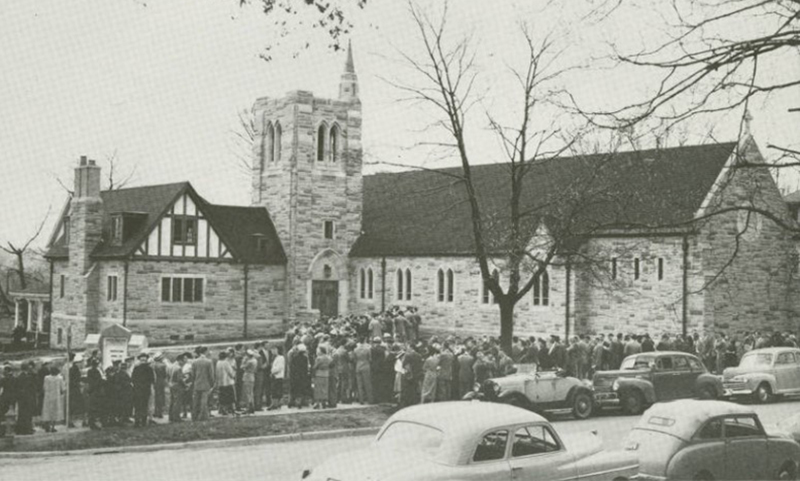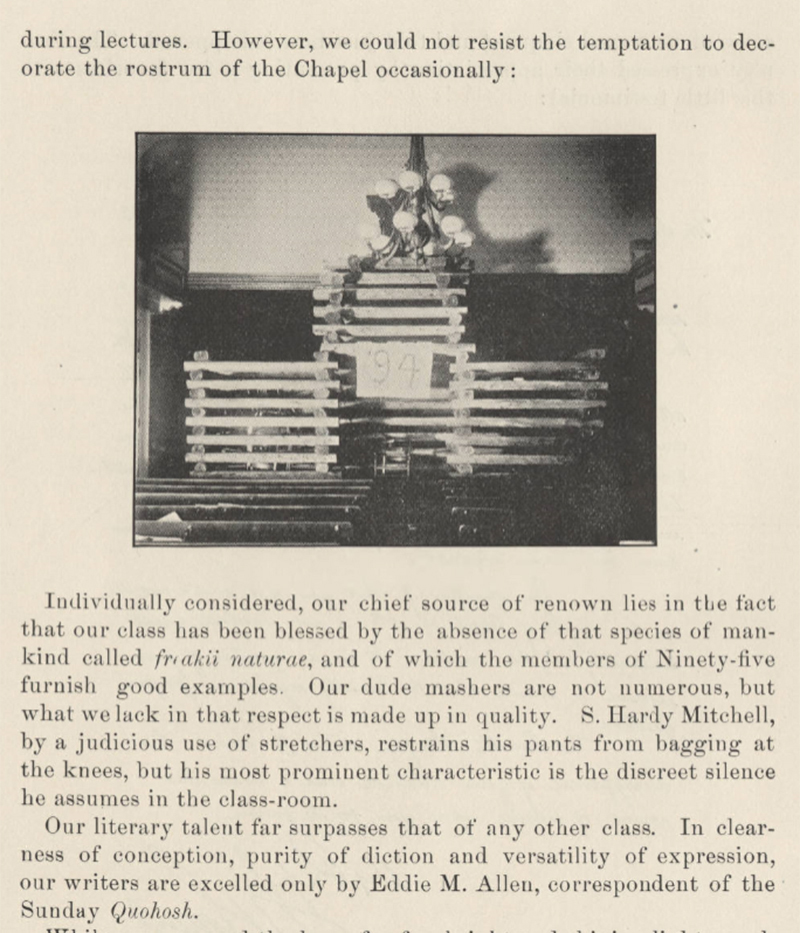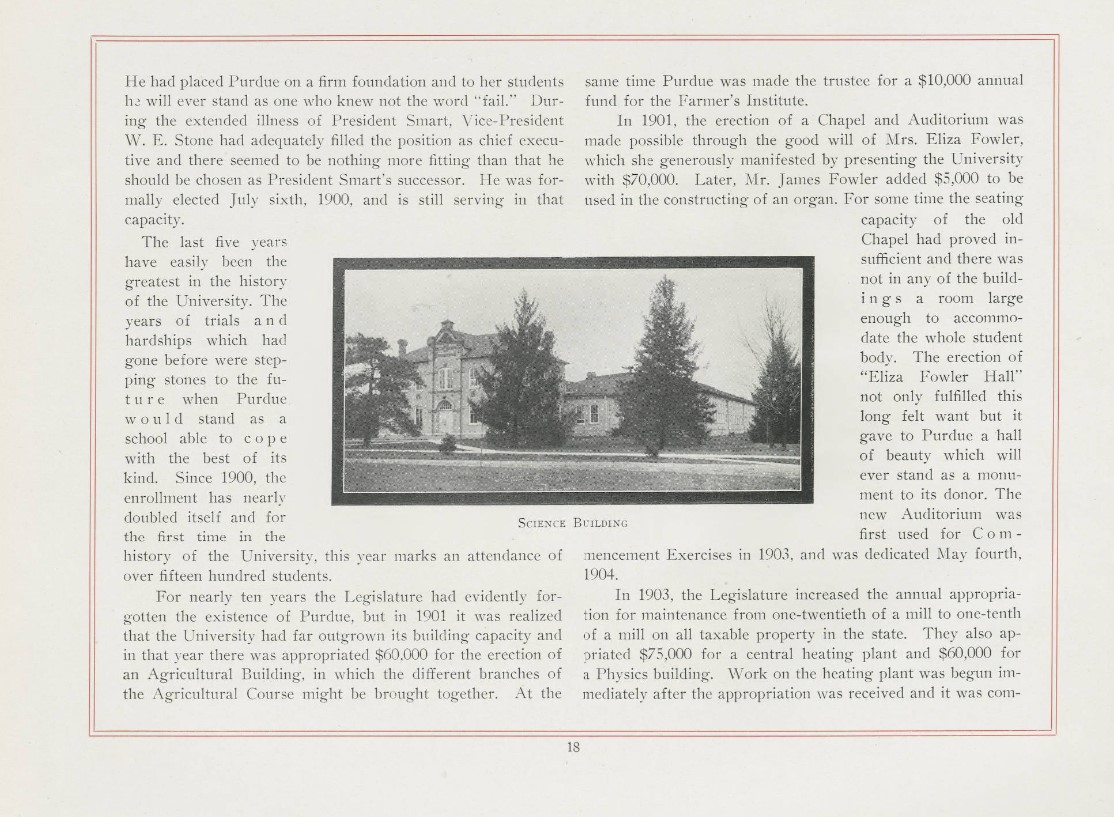Studying religion at Purdue
Professors emeritus in sociology and philosophy examine the history of religious study at Purdue

Religion is a bigger part of Purdue’s history than most people realize, but studying religion at Purdue is a fairly recent development.
In fact, the two of us have witnessed, and actively participated in, most of it – Jim as a sociologist of religion, Don as a philosopher emphasizing Eastern religions, especially Buddhism. Here is the story, as we understand it:
The Morrill Act of 1862
Purdue is a land-grant university. The Morrill Act of 1862 (Section 4) says the following about land-grant schools:
“…the leading object shall be, without excluding other scientific and classical studies and including military tactics, to teach such branches of learning as are related to agriculture and the mechanic[al] arts in such manner as the legislatures of the States may respectively prescribe, in order to promote the liberal and practical education of the industrial classes in the several pursuits and professions in life.”
Thus, the goal of the Morrill Act was to make sure that people of modest means have access to public colleges and universities that emphasize agriculture, mechanical, and other “practical” disciplines such as engineering, technology, and applied sciences. But, the Act also says land-grant schools should pursue this goal “without excluding other scientific and classical studies” – language which leaves a lot of room for interpretation.
According to the Act, decisions about emphasis would be made by state legislatures and are likely to vary from state to state and from time to time.

1869-1930s: Purdue’s Early Years
Using a strict interpretation of the Morrill Act, Purdue’s early presidents and other university officials insisted that Purdue stress agriculture and the mechanical arts, and leave “classical studies” to other – mostly private, church-related – universities.
Thinking of Purdue as an “agricultural college” (President Richard Owen, 1872-74) or an “industrial college” (President Emerson White, 1876-83), they hired faculty who had degrees or first-hand experience in science, agriculture, and engineering, and these people taught a curriculum made up almost entirely of what are now called the STEM disciplines (science, technology, engineering, and mathematics).
When the nation sought answers to agricultural challenges – as it did in the late-1800s – Purdue stressed agriculture, and when society expressed an interest in planes, trains, and other modes of transportation – as it did in the 1920s and ’30s – the university’s attention turned to aviation and engineering (hiring Amelia Earhart, excelling in locomotive testing and design, and having the largest engineering school in the country).
But, the emphasis was always on these “practical” disciplines.
In these early years, the liberal arts played almost no role in Purdue’s curriculum. The university’s curriculum included a handful of “service” courses in the humanities, usually English and history, to increase the communication skills and cultural sophistication of students seeking degrees in science, agriculture, engineering, and technology. But, there were no departments or academic degrees in the humanities or social sciences.

Religion also was not part of the curriculum. It was seen as an extracurricular activity that would build students’ character and make Purdue graduates better citizens.
At first, the university supported these goals directly. The main building (now University Hall) included a chapel, where students were required to go for morning prayers Monday through Friday at 10:15am. Students also were urged to attend a voluntary worship service in the chapel on Sunday afternoons at 3:30.
In the 1930s, the university sponsored a religious convocation series featuring prominent religious leaders. It also initiated an annual Christmas Show.
The earliest church-related campus ministries were sponsored by the YMCA and YWCA in the 1880s, the Wesley Foundation in 1917, University Church in 1919, and the Hillel Foundation in 1939.
As the influence of these campus ministries increased, the university reduced its involvement in religious extracurricular activities. The chapel disappeared; so did morning prayers, the Sunday worship, and the convocation series (the Christmas Show still exists, but is no longer free).
The dominance of the physical sciences, agriculture, and engineering, and the virtual exclusion of the humanities and social sciences are reflected in the university’s official nickname (the “Boilermakers”) and its official mascot (a locomotive).
This also explains the inscription in the stained-glass window in the west wall between the first and second floors of the Purdue Memorial Union: “Our poor spirit is so weak that it is only through the use of materials that it can rise to the truth.”
Thus, from 1869, when Purdue was founded, until the 1940s – a span of about 75 years – Purdue focused on agriculture, engineering, and applied sciences, and offered very little in the liberal arts, including the study of religion.
If you wanted to get an undergraduate degree in civil, electrical, or mechanical engineering, agriculture, technology, or pharmacy, you could do that at Purdue, but if you wanted a degree in philosophy, anthropology, fine arts, or religious studies, you would have to look elsewhere. If you wanted to study farm management or crop rotation, you could do that at Purdue, but if you wanted to study church administration or church growth, you could not.
1940s and 1950s: The Turning Point
In the 1940s and ’50s, the United States was trending away from the rural-agricultural society it had been in the 19th century and the urban-industrial society it had become in the early 20th century and toward a suburban, white-collar society.
With World War II ending and the G.I. Bill going into effect, applications to Purdue jumped about 40% in the mid-1940s. These applicants also were different from previous generations of aspiring students. They included more veterans; more women; more people with diverse racial, ethnic, regional, and religious backgrounds; more people seeking careers in human services and self-expression; and more people who wanted to major in the humanities and social sciences – the liberal arts.
The university could have doubled down on its historical “either-or” approach, emphasizing science, agriculture, and engineering and only admitting applicants who intended to major in these subjects, or it could have adopted a “both-and” approach by retaining its traditional emphasis and adapting to the increasingly humanistic preferences of its recent applicants.
Wisely, it chose the second course of action. In 1946, it selected Fred Hovde as its new president. Hovde approved the formation of several departments in the humanities (e.g., philosophy in 1951) and social sciences (e.g., sociology in 1953). He and his administrative team also authorized the creation of a new School of Science, Education, and Humanities (SEH).
In 1959, with the support of William L. Ayres, the Dean of SEH, Hovde supported and the trustees approved a Bachelor of Arts degree.
1960s to the Present
The university has continued to emphasize agriculture, engineering, and other STEM disciplines. But, in contrast to its first 75 years, when Purdue thought of itself as an “agricultural college” or an “industrial college,” it has increasingly seen itself as a comprehensive state university in the last 75 years.
It still stresses the material, physical, and technological dimensions of life, but now it takes the social, cultural, and spiritual dimensions of life more seriously than ever before.
In 1963, SEH became HSSE (Humanities, Social Sciences, and Education). In 1989, when a separate School of Education was formed, HSSE became SLA (the School of Liberal Arts), and in 2005, SLA became CLA (the College of Liberal Arts). While HSSE was little more than a residual category containing disciplines that were not agriculture and engineering, CLA expresses an understanding that the humanities and the social sciences are crucial components of a liberal arts education.
The College of Liberal Arts now includes four schools, six departments, and 14 interdisciplinary programs. It has about 300 faculty, 140 staff people, and a budget of approximately $70 million.
With regard to religion specifically, campus ministries have continued to grow – St. Thomas Aquinas Center opened its doors in (1951), followed by the Chapel of the Good Shepherd (1956), the Baptist Student Foundation (1959), and the Islamic Society of Greater Lafayette-Purdue Mosque (2001) – and have contributed to Purdue’s reputation in campus ministry circles as “the most religious school in the Big Ten.” But, more importantly, in recent years, religion has become a larger part of Purdue’s academic footprint.
Two departments (philosophy and sociology) have led the way.
Philosophy
The Department of Philosophy was founded in 1951. Its first head, Eric E. Clitheroe, had a doctorate in philosophy and theology from the University of Edinburgh. He created and taught the first courses directly on the study of religion at Purdue: “Religions of the East” and “Religions of the West.”
In preparation for Clitheroe’s retirement in 1973, his position was split for two new scholars, one in Eastern religions (Donald W. Mitchell) and the other in Western religions (Larry E. Axel).
Mitchell specialized in Asian and comparative religions and interreligious dialogue. He published seven books, including "Buddhism: Introducing the Buddhist Experience." Axel was the author of "The Size of God," and his works are collected in "The Works of Larry E. Axel: Studies in Liberal Religious Thought." Both men were popular teachers and attracted many students to their courses.
With encouragement from department head Richard Grabau and Acting Dean of HSSE George P. Salen, the department created an interdisciplinary Religious Studies program within the department. Mitchell became its director.
The department added new courses in religious studies, both in the department and from other departments, and Mitchell and Axel alternated as directors.
As the Department of Philosophy grew, it hired several people who could contribute to Religious Studies.
Michael Bergman and Jeffrey Brower joined the department and collaborated on a number of books on religion including "Reason and Faith: Themes from Swinburne." Paul Draper contributed a skeptical voice to the discussion of religion and published "Renewing Philosophy of Religion: Exploratory Essays." Daniel Frank brought a Jewish perspective and published "Jewish Philosophy Past and Present: Contemporary Responses to Classical Sources." Finally, Daniel Smith is known not only for his research publication, but for the first translation of many of the works of Gilles Deleuze such as "The Logic of Sensation."
Others who were hired were less enthusiastic about having an interdisciplinary religion program within the philosophy department.
Following Axel’s death in 1991, the department hired Jacqueline Marina, who published "Transformation of the Self in the Thought of Friedrich Schleiermacher." She remains a member of the philosophy department as a full professor. When Mitchell retired in 2004, he was replaced by Ashley M. Purpura.
In 2014, Dean John Contreni proposed that the program be moved from Philosophy to the CLA’s new School of Interdisciplinary Studies. The department agreed.
The Religious Studies curriculum now includes the courses on Eastern and Western religions, and selections from 41 other courses in nine departments on three major topics: religious traditions and diversity; religion, society, and the public square; and religion, culture, and intellectual history.
The enrollment in Religious Studies courses is now about 340 students per semester. Approximately 50 students are either majoring or minoring in Religious Studies.
Sociology
The Department of Sociology was founded in 1953. Its first head was sociologist Harold Christensen, who studied the social correlates of intra-faith and inter-faith marriages as part of his research on marriage and the family.
From the 1950s through the 1980s, the department usually had one or two faculty members who were hired to teach in other areas of sociology, but also happened to have interests in religion (e.g., Jeffrey Hadden, Dean D. Knudsen, and James D. Davidson). These professors took turns teaching the one Sociology of Religion course the department offered each year and mentoring the two to three graduate students who wanted to do master’s theses or Ph.D. dissertations on religion.
Hadden left Purdue in the ’60s, and Knudsen’s other interests prevailed in the ’70s. Davidson was the only one left with an interest in teaching the religion course and mentoring the growing number of students wanting to study religion.
Then, the department hired Roger Finke to teach social psychology, but Finke also had an interest in, and a new book on, religion: "The Churching of America, 1776-90." Separately and together, Davidson and Finke developed a curriculum consisting of two courses for undergraduate students (Religion in America and The Social Significance of Religion), two for advanced undergraduates and graduate students (Religion in Social Context and Religion in Society), and a seminar for graduate students (Seminar in the Sociology of Religion).
The two colleagues also obtained external funding for their own research and to support the increasing number of students. They both were active in professional associations related to the scientific study of religion, and they encouraged students to follow their example, which the students did.
When the department reorganized its graduate program, the faculty realized that there was a larger concentration of students, grants, and publications in religion than in some other areas that had more faculty members.
At that point, the department recognized religion as one of its areas of specialization. The foundation had been poured for a program in the sociology of religion at Purdue.
Now, over 20 years later, that program is flourishing under new leadership. It is one of only a few such programs in the United States that has three full-time faculty who specialize in the study of religion.
Fenggang Yang ("Religion in China") is the director of the Center on Religion and Chinese Society and America’s leading authority on religion in China. Dan Olson’s research and many articles in prestigious journals focus on the effects that religious geography has on individuals and organizations in given areas. Olson also has built a well-deserved reputation as a mentor for all students, especially those interested in religion. Daniel Winchester’s research emphasizes the social and cultural correlates of religious conversion.
Winchester’s teaching includes CLA’s Cornerstone Integrated Liberal Arts Program, which encourages about 1,700 students to explore the meaning and significance of the careers they are pursuing. This program does not require that students study religious texts or themes, but it invites them to consider issues such as religion and the meaning of work (as a job, a career, or a calling) and the role that religious and secular worldviews play in people’s responses to technological innovations, social injustice, environmental challenges, and medical breakthroughs.
The department’s five-course curriculum in the Sociology of Religion program remains intact, and enrollments have increased. These courses are now cross-listed in the “Religion, Society, and the Public Square” section of the Religious Studies program.
The professors in the Sociology of Religion continue to get outside funding (over $10 million) to support their work and the work of their graduate students. Each of the sociologists also mentors five to 10 graduate students, most of whom go on to jobs in research-oriented universities, liberal arts colleges, and other workplaces related to higher education.
Among sociologists of religion, Purdue’s Sociology of Religion program is considered one of the best in the country.
Conclusions
A few years ago, a Purdue professor was in southern California, speaking to a large group of church leaders about his research on generational differences in religious commitment. When the professor finished his talk, a man approached the podium, gave his name, and said:
“I’m a Purdue grad.”
“It’s a pleasure meeting you, sir,” the professor replied. “When were you at Purdue?”
“Oh, it was years ago,” the man said. “Purdue wasn’t doing your kind of research back then!”
“Things have changed,” the professor observed discreetly.
“They sure have!” the man exclaimed. “And for the better!” he added.
We concur.
In its early years, Purdue thought of itself as an industrial and/or agricultural college. Its leaders worked with an either-or view of mechanical arts vs. liberal arts, agricultural studies vs. classical studies, science vs. the humanities, and the material aspects of life vs. the cultural aspects. They emphasized agriculture and the mechanical arts, leaving religion and classical studies such as philosophy, Latin, and fine arts to private schools.
In the 1940s and ’50s, Purdue faced a choice: continue to be an “ag and engineering” school, or become a more well-rounded university. With considerable wisdom and courage, President Hovde and other university officials chose the second option.
Since the Hovde years, university leaders have stressed a both-and approach, reaffirming the university’s emphasis on the mechanical arts and increasing its commitment to the liberal arts. They have reassured the Purdue community that the university will continue to stress the material and practical aspects of life, while paying more attention to the human and social aspects.
Like the Purdue grad at the conference in southern California, we believe the Purdue experience can and should include studying engineering and studying religion. The more it does, the more competitive Purdue will be among the nation’s finest land-grant universities.